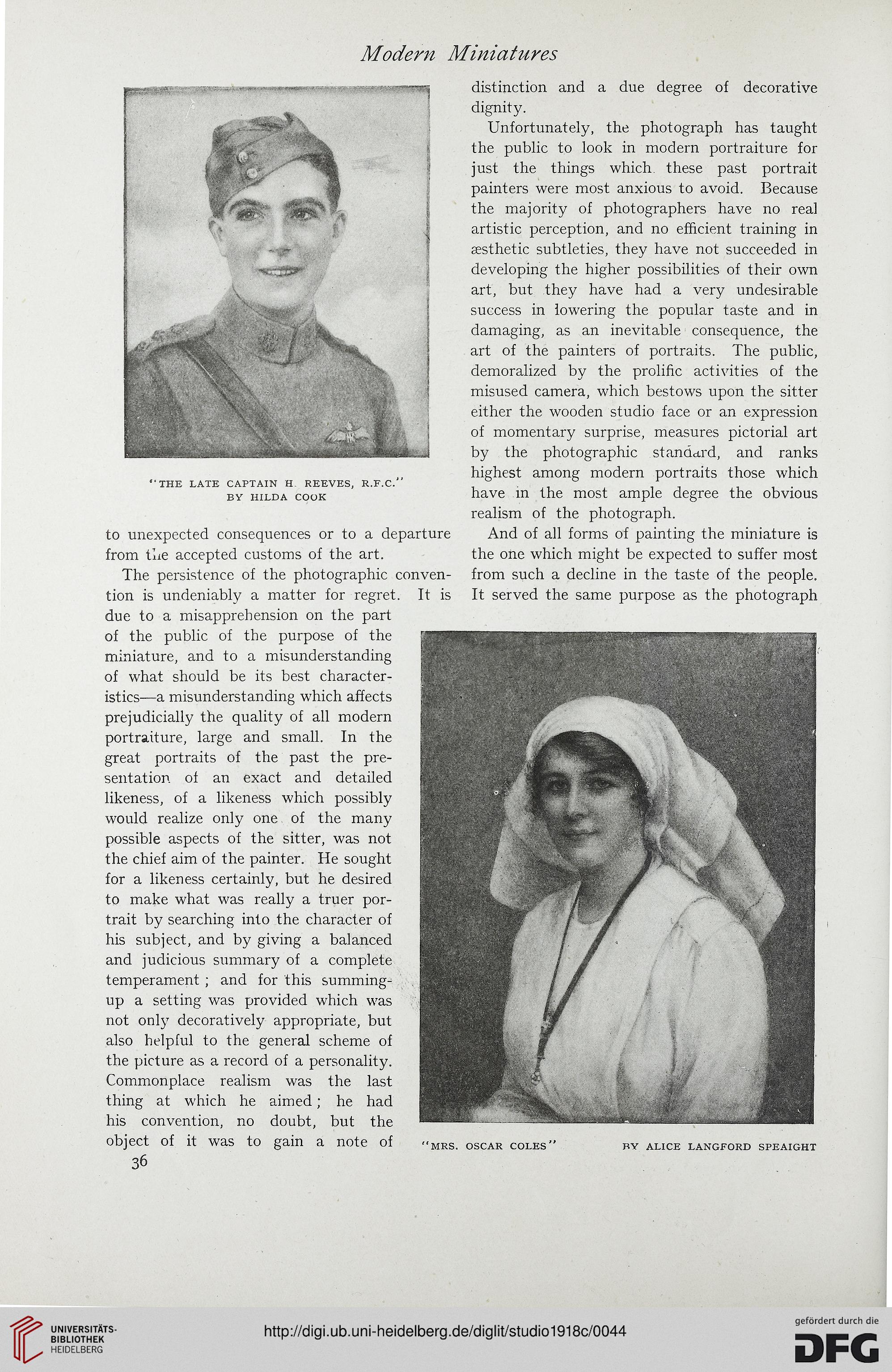Modern Miniatures
distinction and a due degree of decorative
dignity.
Unfortunately, the photograph has taught
the public to look in modern portraiture for
just the things which these past portrait
painters were most anxious to avoid. Because
the majority of photographers have no real
artistic perception, and no efficient training in
aesthetic subtleties, they have not succeeded in
developing the higher possibilities of their own
art, but they have had a very undesirable
success in lowering the popular taste and in
damaging, as an inevitable consequence, the
art of the painters of portraits. The public,
demoralized by the prolific activities of the
misused camera, which bestows upon the sitter
either the wooden studio face or an expression
of momentary surprise, measures pictorial art
by the photographic standard, and ranks
highest among modern portraits those which
" the late captain h reeves, r.f.c. , < •- , • .
by hilda cook have in the most ample degree the obvious
realism of the photograph,
to unexpected consequences or to a departure And of all forms of painting the miniature is
from the accepted customs of the art. the one which might be expected to suffer most
The persistence of the photographic conven- from such a decline in the taste of the people,
tion is undeniably a matter for regret. It is It served the same purpose as the photograph
due to a misapprehension on the part
of the public of the purpose of the
miniature, and to a misunderstanding
of what should be its best character-
istics—a misunderstanding which affects
prejudicially the quality of all modern
portraiture, large and small. In the
great portraits of the past the pre-
sentation of an exact and detailed
likeness, of a likeness which possibly
would realize only one of the many
possible aspects of the sitter, was not
the chief aim of the painter. He sought
for a likeness certainly, but he desired
to make what was really a truer por-
trait by searching into the character of
his subject, and by giving a balanced
and judicious summary of a complete
temperament ; and for this summing-^
up a setting was provided which was
not only decoratively appropriate, but
also helpful to the general scheme of
the picture as a record of a personality.
Commonplace realism was the last
thing at which he aimed; he had
his convention, no doubt, but the
object of it was to gain a note of <*mrs. oscar coles" by alice langford speaight
36
distinction and a due degree of decorative
dignity.
Unfortunately, the photograph has taught
the public to look in modern portraiture for
just the things which these past portrait
painters were most anxious to avoid. Because
the majority of photographers have no real
artistic perception, and no efficient training in
aesthetic subtleties, they have not succeeded in
developing the higher possibilities of their own
art, but they have had a very undesirable
success in lowering the popular taste and in
damaging, as an inevitable consequence, the
art of the painters of portraits. The public,
demoralized by the prolific activities of the
misused camera, which bestows upon the sitter
either the wooden studio face or an expression
of momentary surprise, measures pictorial art
by the photographic standard, and ranks
highest among modern portraits those which
" the late captain h reeves, r.f.c. , < •- , • .
by hilda cook have in the most ample degree the obvious
realism of the photograph,
to unexpected consequences or to a departure And of all forms of painting the miniature is
from the accepted customs of the art. the one which might be expected to suffer most
The persistence of the photographic conven- from such a decline in the taste of the people,
tion is undeniably a matter for regret. It is It served the same purpose as the photograph
due to a misapprehension on the part
of the public of the purpose of the
miniature, and to a misunderstanding
of what should be its best character-
istics—a misunderstanding which affects
prejudicially the quality of all modern
portraiture, large and small. In the
great portraits of the past the pre-
sentation of an exact and detailed
likeness, of a likeness which possibly
would realize only one of the many
possible aspects of the sitter, was not
the chief aim of the painter. He sought
for a likeness certainly, but he desired
to make what was really a truer por-
trait by searching into the character of
his subject, and by giving a balanced
and judicious summary of a complete
temperament ; and for this summing-^
up a setting was provided which was
not only decoratively appropriate, but
also helpful to the general scheme of
the picture as a record of a personality.
Commonplace realism was the last
thing at which he aimed; he had
his convention, no doubt, but the
object of it was to gain a note of <*mrs. oscar coles" by alice langford speaight
36




